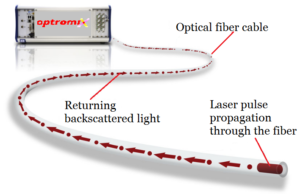 The main idea of the Distributed Temperature Sensing is Raman-based temperature measurement joined with Optical Time-domain Reflectometry (OTDR). A short pulse of light is enabled into the fiber. The propagating light creates Raman backscattered light at two wavelengths, from all points along with the fiber. The wavelengths of the Raman backscattered light are different from that of the forward propagating light and are named “Stokes” or “anti-Stokes”.The amplitude of the Stokes light is not very dependent on temperature, while the amplitude of the anti-Stokes light is strongly dependent on temperature.
The main idea of the Distributed Temperature Sensing is Raman-based temperature measurement joined with Optical Time-domain Reflectometry (OTDR). A short pulse of light is enabled into the fiber. The propagating light creates Raman backscattered light at two wavelengths, from all points along with the fiber. The wavelengths of the Raman backscattered light are different from that of the forward propagating light and are named “Stokes” or “anti-Stokes”.The amplitude of the Stokes light is not very dependent on temperature, while the amplitude of the anti-Stokes light is strongly dependent on temperature.
A typically distributed sensing system is described by the spatial and temperature resolution. The spatial resolution is the minimum distance of the sensor to measure a step change in temperature along with the optical fiber. The temperature resolution is a measure of the precision to distinguish the absolute temperature. The temperature resolution depends on the measurement time and the launch pulse-recurrence rate. The laser pulse energy and duration are accurately controlled and optimized at the measurement maximum length to provide the best available temperature resolution within acceptable accuracy limits. As the sampling time is increased, the temperature resolution is improved and resolved temperatures become more accurate.
The report “Distributed Temperature Sensing (DTS) Market 2016 – 2023,” points out the key factors impacting the growth of this market and assesses its growth during the period between 2016 and 2023. Fiber optic sensing is challenging because the physical properties of light into the fiber are affected by strain, temperature, or sound. Several technologies enable local measurement – using sensors at chosen points along with the fiber (eg, fiber Bragg grating (FBG) technology for measuring localized pressure, strain, temperature, and flow) – or distributed sensing – with sensing occurring all along with the fiber.
Distributed sensing systems have been developed for the oil and gas industry to assist reservoir engineers in optimizing the well lifetime. Nowadays they find a wide variety of applications as integrity monitoring tools in process vessels, storage tanks, and piping systems offering the operator tools to schedule maintenance programs and maximize service life.
Optromix Company offers a Distributed fiber optic sensing system with high spatial and temporal profiling over large surfaces, long lengths, and at locations where conventional point sensing is not applicable or costs effective.

